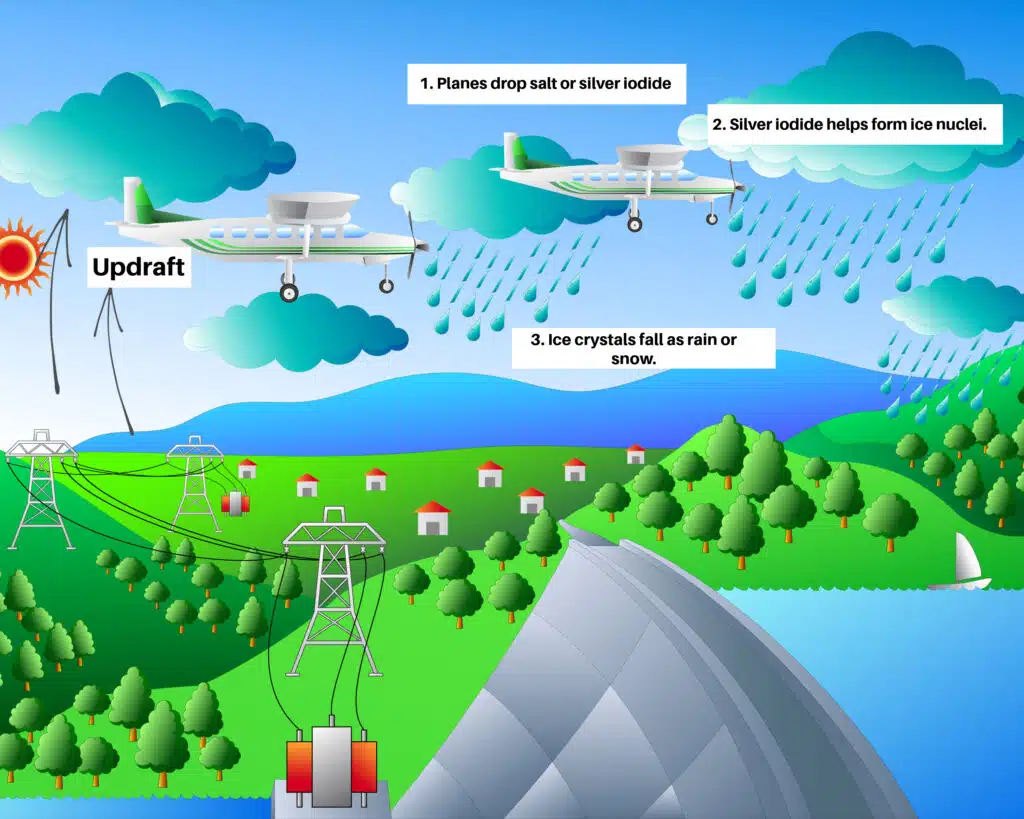Syllabus: GS-III: Pollution
Why in the News?
Delhi’s government recently announced plans to conduct cloud seeding operations as an emergency response to worsening winter air pollution. The move, marketed as an innovative scientific intervention, aims to trigger artificial rainfall to clear smog and improve air quality. However, atmospheric experts and environmental scientists have questioned the scientific validity, ethical prudence, and sustainability of such a measure. Given the recurring public health crisis in North India’s winter months, this debate exposes the policy tendency to seek technological quick fixes instead of addressing the root causes of pollution — emissions from vehicles, stubble burning, construction dust, and industrial activities.
What Is Cloud Seeding?
Cloud seeding is a weather modification technique designed to enhance precipitation by dispersing substances into the air that serve as cloud condensation or ice nuclei, encouraging water droplets or ice crystals to form and fall as rain or snow.
- The most commonly used substances are silver iodide, potassium iodide, dry ice (solid CO₂), and sodium chloride.
- The method requires existing clouds with sufficient moisture; it cannot create clouds in clear skies.
Cloud seeding can be performed using aircraft, rockets, or ground-based generators that release these particles into the atmosphere.

Various Methods of Cloud Seeding
- Static Cloud Seeding: Involves dispersing chemical agents such as silver iodide into clouds to encourage condensation and the formation of rain droplets.
- Dynamic Cloud Seeding: Focuses on enhancing the vertical air currents within clouds, increasing their ability to absorb moisture and trigger precipitation.
Hygroscopic Cloud Seeding: Uses salts like sodium chloride or potassium chloride to attract moisture, promoting droplet growth in warm clouds.

Significance of Cloud Seeding
- Rain Induction: Aimed at increasing rainfall in drought-prone or arid regions to support agriculture and water reservoirs.
- Air Quality Improvement: Believed to help settle airborne pollutants temporarily after induced rainfall.
- Disaster Mitigation: Potential to manage hailstorms or suppress fog at airports.
- Water Resource Management: Used in countries such as China, Israel, and the United Arab Emirates to augment freshwater supply.
However, the effectiveness of cloud seeding remains scientifically inconclusive. The World Meteorological Organization (WMO) notes that only marginal precipitation enhancement (5–20%) has been observed in controlled conditions, and results are highly variable.
Criticisms and Limitations of Cloud Seeding
- Dependence on Atmospheric Conditions: Cloud seeding can only occur when suitable clouds already exist — a rarity during Delhi’s cold, dry, and stable winter months.
- Weak Scientific Evidence: Global studies show no consistent, replicable results demonstrating significant rainfall enhancement or long-term pollution reduction.
- Temporary Relief: Even if successful, any rain-induced pollutant washout lasts only 1–2 days, with pollution levels rebounding soon after.
- Environmental and Health Risks: Silver iodide, though used in small quantities, can accumulate in soil and water, posing potential toxicological and ecological risks.
- Long-term exposure may affect aquatic ecosystems and agriculture.
- Ethical and Governance Issues: Lack of accountability if seeding coincides with flooding or crop damage.
- Misuse of public funds for scientifically uncertain projects diverts resources from proven solutions.
- Consent and liability concerns if operations affect neighbouring regions.
About Delhi’s Air Pollution
- Delhi’s Air Quality Index (AQI) frequently exceeds 400–500, categorised as Severe by the Central Pollution Control Board (CPCB).
- During winter (October–January), stagnant winds, temperature inversion, and dry air trap pollutants close to the surface.
- Major sources:
- Vehicular emissions (~40%)
- Construction dust (~30%)
- Biomass and stubble burning in Punjab and Haryana (~25%)
- Industrial and thermal power emissions
- According to the Lancet Planetary Health Report (2023), 1.67 million deaths annually in India are attributed to air pollution; Delhi ranks among the most polluted capitals globally.
Why Cloud Seeding Is Not a Solution to Delhi’s Air Crisis?
- Absence of Clouds: Winter atmospheric conditions in Delhi — low humidity, temperature inversion, and weak convection — do not support the formation of seedable clouds.
- The atmosphere is too dry for meaningful rainfall.
- Unreliable and Unsustainable: Any rain would provide short-lived respite, failing to address the underlying emissions from transport, agriculture, or energy sectors.
- Diverts Policy Attention: Such measures risk deflecting accountability from agencies responsible for emission control, waste management, and agricultural practices.
- Public Resource Misallocation: Cloud seeding operations can cost ₹10–15 crore per attempt, with negligible scientific return. Funds could instead be used for pollution control infrastructure or electric mobility initiatives.
- Ethical and Environmental Concerns: Introducing chemicals into the atmosphere for an unproven benefit violates principles of precautionary environmental governance.
- Could create public distrust if perceived as political optics rather than evidence-based action.
In simple terms: Delhi’s winter sky is dry and stable — not conducive to natural or artificial rainfall. Cloud seeding, therefore, is meteorologically futile.
Way Forward
- Structural Emission Reduction: Implement Clean Fuel and Mobility Transition Plans (electrification of buses, trucks, and two-wheelers).
- Strict enforcement of GRAP (Graded Response Action Plan) and NCR-wide emission coordination.
- Agricultural Policy Reform: Scale up in-situ crop residue management (Happy Seeder, bio-decomposers) to eliminate stubble burning.
- Incentivise alternative crop cycles and sustainable farming.
- Industrial and Energy Measures: Tighten emission norms for thermal plants and brick kilns; promote renewable energy integration.
- Urban Planning: Expand green buffers, control construction dust through on-site dust suppression systems.
- Promote compact, mixed-use urban design to reduce transport emissions.
- Data and Health-Centric Governance: Continuous air quality monitoring; integrate public health advisories and medical preparedness for pollution spikes.
- Scientific Integrity and Policy Ethics: Encourage peer-reviewed, transparent evaluation of experimental interventions before large-scale funding.
- Promote environmental literacy so that citizens can differentiate genuine science from political theatrics.
- Promote environmental literacy so that citizens can differentiate genuine science from political theatrics.
Conclusion
Delhi’s recurring air crisis cannot be solved by rain-making illusions. Cloud seeding, though appealing for its dramatic imagery, is scientifically weak, environmentally uncertain, and ethically dubious. The true test of governance lies not in manipulating the weather but in reforming energy, agriculture, transport, and waste systems — the real sources of pollution. Clean air will come not from chemicals in clouds but from courage in policy: the courage to implement hard, structural reforms.
Sample Mains Question
Q: “Technological quick fixes like cloud seeding divert attention from long-term structural reforms needed to tackle India’s air pollution crisis.” Discuss.
Share This Story, Choose Your Platform!
Start Yours at Ajmal IAS – with Mentorship StrategyDisciplineClarityResults that Drives Success
Your dream deserves this moment — begin it here.


